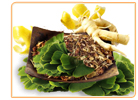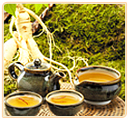Uses of Ginseng
Ginseng�s uses vary depending on the type of root being used. In China and other parts of Asia the precise healing properties of ginseng are based on tradition and cultural use. In the Western world however, the herb has come under a great deal of scrutiny. Because of this, ginseng�s specific health benefits are constantly being reviewed and updated in modern day medicine. An overview of its uses can be found below.
The word "Panax" comes from the Greek word for �Panacea� which translates as "all-healing" in Chinese. This is representative of the numerous ailments ginseng is used to alleviate.
Cultural Practices and Traditional Uses of Ginseng
 The Native Americans and the Chinese, who first discovered ginseng, also identified its basic health benefits. They found that it could be used to improve resistance to illness and to aid the recovery process. The Native Americans and the Chinese, who first discovered ginseng, also identified its basic health benefits. They found that it could be used to improve resistance to illness and to aid the recovery process.
Because of its human-like shape, many people in China believe that ginseng confers the person consuming it with the herbs life. For this reason, versions of the herb that have been growing for many years are treasured.
At its core, ginseng is used to revitalize and strengthen the body. Both the American ginseng (Ying) and Asian ginseng (Yang) are also used to improve the body�s resistance to harm.
Modern Day Uses
Modern day uses of ginseng are based more on extensive scientific clinical trials than culture and tradition uses. These modern day uses include:
As an Energizer: Both American and Asian ginseng are used in the rehabilitation of patients, because they aid the body's natural ability to heal. American ginseng has been proven to be less stimulating and easier to consume over long periods than its Asian equivalent, but both are used to support the body's immune system.
As Treatment for Sexual Dysfunction Problems: Red ginseng is primarily used to deal with sexual dysfunction because it works as a stimulant. It is highly sought-after to treat this debilitating medical problem.
 For Treating Menopause Symptoms: Ginseng has differing benefits and side effects depending on who is taking it. But despite contradictory results, women often use ginseng to alleviate menopausal symptoms such as insomnia. Ginseng can help some women to sleep but it can also lead others to have restless nights. As a phytoestrogenic herb a great deal of care should be taken prior to its use. A consultation with medical professionals is advised because ginseng has the potential to cause postmenopausal bleeding and breast tenderness. For Treating Menopause Symptoms: Ginseng has differing benefits and side effects depending on who is taking it. But despite contradictory results, women often use ginseng to alleviate menopausal symptoms such as insomnia. Ginseng can help some women to sleep but it can also lead others to have restless nights. As a phytoestrogenic herb a great deal of care should be taken prior to its use. A consultation with medical professionals is advised because ginseng has the potential to cause postmenopausal bleeding and breast tenderness.
Considered a "normalizer" and "energizer", ginseng is often used to treat mental well-being and is a well-known reliever of stress, fatigue, and nervousness. All of these ailments can be problematic for menopausal women.
Modern day testing of ginseng has shown that it has other significant benefits when combined with other herbs. The details of which are expanded upon below.
Ginseng and Other Herbs
 Clinical trials have found that combining Korean ginseng with the herb gingko biloba significantly improved the mental performance of a sample of people. It helped them concentrate for longer periods and improved focus, as well as fluency for lectures and presentations. This combination is regularly used by students to improve their academic performance. Clinical trials have found that combining Korean ginseng with the herb gingko biloba significantly improved the mental performance of a sample of people. It helped them concentrate for longer periods and improved focus, as well as fluency for lectures and presentations. This combination is regularly used by students to improve their academic performance.
Ginseng comes in a variety of forms and these are described in the next section.
Different Ginseng Products
 Tea: Ginseng herbal tea is made from the root of the plant and confers the health benefits of its ginsenosides to the drinker. Tea: Ginseng herbal tea is made from the root of the plant and confers the health benefits of its ginsenosides to the drinker.
Powder: The mature white form of ginseng is often dried, cut, and ground into a fine powder for easier consumption. This form of ginseng can be mixed with water and drunk.
Extract: Ginseng extract is occasionally mixed with other beneficial multi-vitamin supplements. Such supplements come in the form of capsules and pills.
Dosage of Ginseng
For products such as ginseng green tea, measures of ginseng are metered for safe usage. Drinkers of this should follow the dosage instructions provided on the products� packaging. Most types of tea come in the form 3 gram tea bags. The extracted capsule or pill form normally contains 500mg of ginseng. The correct dosage is dependent on the reason it has been prescribed or the potency of the prescription itself.
In its powdered form it's recommended that people use 2 teaspoons per day, 40 minutes after eating a meal.
A lesser dosage is advised for those with medical problems, such as sufferers of diabetes or heart disease. This is because they may be more susceptible to side effects.
For the combination of ginseng and gingko to work sufficiently, 600mg or 3g of the ginseng root should be taken with the ginkgo leaf.
Ginseng Overdose
As a pathogen that relaxes the body, large amounts of ginseng is usually harmless. The risk is greater for people who may be more vulnerable to its phytoestrogenic effects. Such effects are particularly potent in the young and pregnant women and any use or overuse can be notably harmful.
Signs of a ginseng overdose can be identified by an increase in the usual side effects of ginseng. Particularly:
 . Low blood sugar . Low blood sugar
. A rapid heart beat
. Easy bruising
. Bleeding that is slow to stop
. Heart palpitations
Now that what ginseng is used for has been explained. Continue reading to better understand the benefits of ginseng.
Conclusions about Ginseng
Ginseng is great for treating some menopause symptoms, but it has recently been criticized because it adds artificial hormones to the body. In so doing, ginseng can trigger side effects including serious conditions such as breast cancer. Other alternative treatments are just as effective as ginseng, but without the side effects. Non-estrogenic herbs, for example, are a great option for treating menopause symptoms. Read more in the following article.
Which herb should women try? Today women are looking for relief from their menopause symptoms with herbs. Phytoestrogenic herbs and non-estrogenic herbs are good in relieving menopause symptoms, but recent studies show that non-estrogenic herbs have no side effects because they help the body to produce its own hormones instead of introducing hormones like the phytoestrogenic ones. Learn more about non-estrogenic herbs for menopause.
| 

